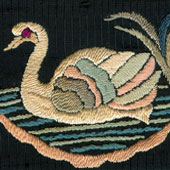Import of Embroidered Silks:
The import of silks, embroidered borders and embroidered nightwear, kimonos, unstitched fabric, caps and shoes was a result of Sino-India trade. The embroidery was done in Canton (now Guangzhou) and the importers mostly Parsi merchants. These silks were often bought and sold by the weight. This explains why the embroidery was economically rendered as it did not cover the sari areas that were tucked or not visible. This also explains the popularity of the embroidered borders. Saris were bought plain, by the weight, and then borders bought separately and stitched on. This also gave the added advantage of flexibility for borders could be then switched from sari to sari. My own maternal grandmother, for example, would wear one border with a sari and then switch the border to another sari so as not to "repeat" her garment more than once! (Incidentally, she also had several single earrings made to be worn on the one earlobe that was visible as the other ear was covered with the "sor" or tail end of the sari pallau and therefore not visible!)

Present Status of Embroidered Saris and Borders:
Towards the middle of the 20th century, the Sino- India trade petered out but the popularity of the borders and embroidered textiles remained constant. To make up for the lack of supply, Indian craftsmen produced the zardosi borders in gold and silver to keep up with the demand, changing the nature of the traditional Parsi embroidered “kor” sari. European and British mills also made their contributions to the market with their English designs and patterns reinforcing their social acceptance in an Anglophile Parsi society. Whatever the reason of losing its source of supply back then, it is a fact that the Parsi "garas" and "kor" saris are here to stay no doubt aided by recent efforts of PARZOR (a UNESCO recognised non-governmental organisation dedicated to the restoration and revival of this art in India) and have become a vital part of both Parsi and non-Parsi bride trousseaus in Mumbai.



